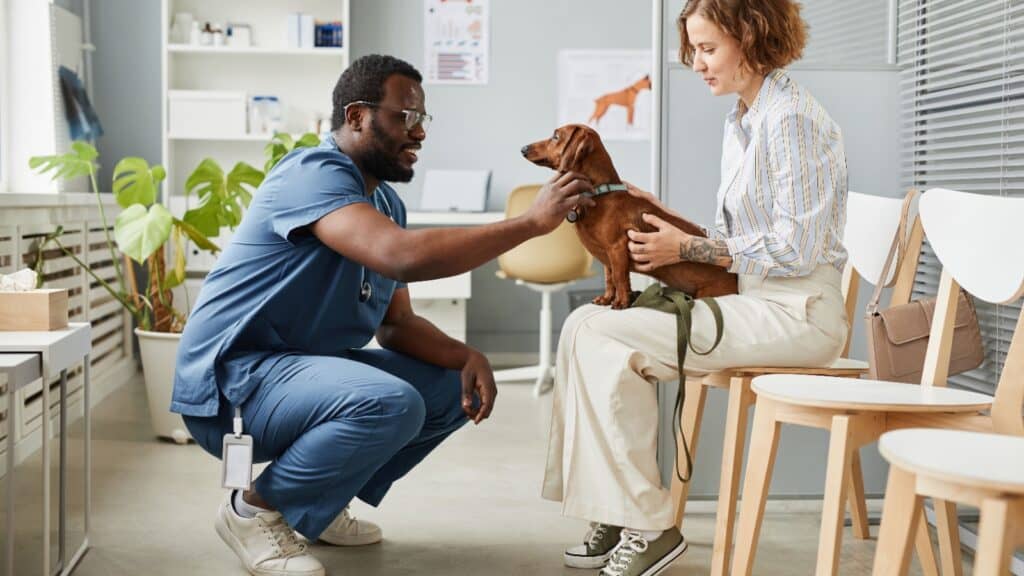How to Protect Your Dog from Heat Stroke This Summer and What NOT To Do!
Summer is here and it’s essential to prioritize your dog’s safety and well-being by taking proactive steps to prevent overheating. Dogs are more susceptible to heat-related illnesses due to their inability to sweat like humans, making it crucial for pet owners to be aware of the signs, prevention methods, and emergency procedures to ensure their dog stays cool and healthy. In the most serious cases of canine dehydration, severe fluid shortage can lead to the failure of the kidneys and other organs.
In addition, we keep seeing posts, on Facebook in particular, that have incorrect, and even dangerous information. All of the information here is evidence-based.
Be Prepared!

Several years ago, I was driving back from a dog show in West Virginia and pulled over at a rest stop on the New Jersey Turnpike. We pulled into a parking spot right in front of a woman who was sitting on the grass with a dog, that was lying down, and I immediately knew what was going on.
I ran over to her and asked her if everything was OK, and she said no, her dog was overheating. I jumped into action. We must’ve looked like a combination of mobile canine triage unit and clown car because I started pulling out cooling mats, coolers of ice water, spray bottles, wet coats, battery operated fans and the like. Further down in this article we will address all of these things. I was prepared because we were traveling with our dog, and it was summer. I understand that the typical pet owner does not usually have all of these accessories, but when you travel with your dog a lot you learn a thing or two, or three.
By the way, the dog had been in an air conditioned car with its humans, but it was in the back under a window where the sun had been beating down. Overheating can happen really quickly.
Quick Guide to Cooling Down An Overheated Dog

Dr. Janice Baker DVM, DACVPM, Ret. COL, USAR Veterinary Corps, of The Veterinary Tactical Group is one of world’s leading experts on thermoregulation. Her work focuses on operational working canines, but the information applies to all of our canine pets as well.
Here, at a glance, is what you need to do with an overheating dog:
- Stop exercise or remove dog from heat source.
- Actively and aggressively cool the dog with whatever you have that is colder than the dog: cold water, ice water, ice packs, fans, bottled water, natural bodies of water, etc. (The no cold or no ice water concept is a myth and has been debunked by scientific research).
- Cool first, then transport. Get their life-threatening temperature down before transporting to veterinary care because transport without cooling just lets them “cook” longer. (AC helps but is not enough).
Prevention!

We are hoping you are not dealing with an acute situation, so let’s discuss prevention. To keep your dog from overheating, follow these effective methods:
Provide Adequate Shade and Ventilation

Ensure your dog has access to shaded areas, especially during peak sun hours. Proper ventilation in your home and vehicle is crucial to prevent heat buildup. For instance, a doghouse in the sun can be hotter inside the house, and we saw what happened to the dog in the air-conditioned car, where it did not have access to the cooling as the human occupants did. Check with actual thermometers to monitor areas.
Dogs + Cars + Heat = Disaster

Never leave your dog unattended in a vehicle, even for a short period (mere minutes), as temperatures can quickly rise to dangerous levels.
Monitor Temperature and Humidity

Be aware of the heat index and humidity levels. Avoid exercising your dog during extreme heat conditions. Even a leisurely walk should be curtailed on super-hot days. Dogs can be allowed to urinate and defecate and then go back inside to a cool area.
Hydrate: Water Should Always Be Available

Provide plenty of fresh water at all times. There are canine specific electrolyte liquids, which are generally preferred over those made for human consumption; please consult with your veterinarian before giving.
Pack portable water bowls. Keep extras in cars.
At dog shows, we have been known to give dogs water with a spray bottle by inserting it directly into their mouths. Generally, you want the dog to drink in its own, but occasionally you have to be proactive.
In extreme situations, a vet can administer subcutaneous or intravenous fluids to most quickly replace the fluids that were lost and prevent further loss.
Limit Exercise

Avoid strenuous activities during hot weather. If you must exercise your dog, do so during cooler parts of the day and keep sessions short. In extreme heat, no exercise is recommended.
Watch for Signs of Overheating

Monitor your dog for signs of overheating. According to Dr. Jerry Klein, Chief Veterinary Officer for the AKC and an expert in veterinary emergency and critical care, symptoms of canine dehydration include:
- Loss of skin elasticity
- Loss of appetite
- Vomiting (with or without diarrhea)
- Reduced energy levels and lethargy
- Excessive panting
- Sunken, dry-looking eyes
- Dry nose
- Dry, sticky gums
- Thick saliva
How To Assess Skin Elasticity

Testing a dog’s skin elasticity is a useful method to check for dehydration. Gently pinch a small section of the dog’s skin near their shoulder blades, lifting it up, and then releasing it. Observe how quickly the skin returns to its original position. In a well-hydrated dog, the skin will quickly snap back into place. In a dehydrated dog, the skin will return more slowly.
Of course, it is best if you have done this when the dog is well hydrated so that you have comparison. This is particularly important for owners of breeds with loose skin, such as Bulldogs or Neapolitan Mastiffs, whose skin might naturally be less elastic.
Gum Appearance Can Help Determine Dehydration

Another method to check for dehydration in your dog is to examine their gums to see if they feel sticky or dry. Additionally, you can test capillary refill time by pressing your finger gently against your dog’s gums and then releasing it. In a well-hydrated dog, the area you pressed will turn white briefly and then quickly return to its normal pink color. However, in a dehydrated dog, this process will take significantly longer.
Additional Cooling Measures

Those of us who show dogs in the summer keep these tools available at all times:
- Fans: We keep several Ryobi fans in the car, large and small. The larger ones can run on AC as well as rechargeable batteries; the smaller ones use batteries. Misting fans are also available.
- Cooling Pads or Mats: Dogs can lay on them to aid in cooling.
- Cooling Vests or Coats: Also called “wet coats”, these are specialized vests or coats that help keep your dog cool, after soaking in cold water. They have an inner layer that is absorbent; you soak them in ice water, wring out, and place on dog. As you can see above, they can be quite decorative!
- Spray Bottles: Used to hydrate your dog. You can spray cool water right into their mouths.
What Is A Misting Fan?

These are fans that have an attachment that syphons water up from a reservoir (often simple bucket) and sprays out a fine mist of cold water along with the fan moving air around. They are incredibly refreshing. That is my friend D’Tango in the photo, wearing goggles for eye protection, and looking cool while cooling off.
More Cooling Accessories

- Sun Shades: There are products for car/RV windows (seen above), and also large tarps made of woven aluminum fabric (such as Aluminet) that can be draped on cars and tents to cool the area.
- Cooling Treats: Provide cooling treats like frozen Kongs or frozen peanut butter-filled toys.
- Provide a Kiddie Pool or Water Source: Allow your dog to cool off in a kiddie pool or provide a water source for them to wade in.
- Avoid Muzzling: Avoid muzzling your dog during hot weather as it can interfere with their ability to pant and cool themselves.
What About Isopropyl Alcohol?

Occasionally you will see the recommendation for dabbing the bottom of the dog’s paws with isopropyl alcohol to cool them quickly. According to evidence-based studies, “water immersion cooled dogs more efficiently than isopropyl alcohol. Additionally, the application of isopropyl alcohol raised dogs’ heart rates more than water immersion or no intervention, suggesting that the process of applying isopropyl alcohol is potentially stressful to dogs.”
When To Seek Medical Attention

If you suspect your dog is overheating, seek immediate veterinary attention. Signs of severe overheating include:
- High Body Temperature: A body temperature above 104°F (40°C) is a medical emergency.
- Seizures: If your dog experiences seizures, it is a severe sign of overheating.
- Coma: If your dog becomes comatose, it is a life-threatening condition.
The Takeaway

Remember, prevention is key. Always prioritize your dog’s safety and well-being during hot weather.
How Many Of These Foods Did You Know Could Kill Your Dog?

Our canine companions bring immense joy into our lives, and it’s our duty to ensure their well-being. However, certain everyday foods found in our homes can pose serious risks to their health. Here’s a look at foods that should never be fed to dogs or left within their reach.
To be prepared, have contact details of your local veterinarian, the nearest emergency clinic, and the ASPCA Animal Poison Control Center (888-426-4435) at hand. READ: How Many Of These Foods Did You Know Could Kill Your Dog?
Understanding The Surge In Veterinary Costs: Is It Becoming Too Expensive To Have A Pet?

If you own a pet, we bet you have noticed that veterinary care costs are escalating, leaving many of us with sticker shock and struggling to secure timely appointments. There are reasons for this burgeoning phenomenon; we unveil the many factors steering this surge. Read: Understanding The Surge In Veterinary Costs: Is It Becoming Too Expensive To Have A Pet?
Join Us

Join us on this empowering journey as we explore, celebrate, and elevate “her story.” The Queen Zone is not just a platform; it’s a community where women from all walks of life can come together, share their experiences, and inspire one another. Welcome to a space where the female experience takes center stage. Sign up for our newsletter so you don’t miss a thing, Queen!







